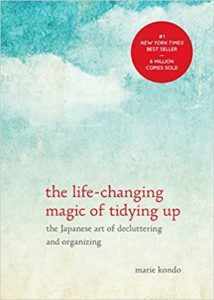September 7, 2018. By Lori Patterson:
For many, the act of tidying is a dreaded chore and unpleasant experience. It may bring to mind the daunting tasks of spring cleaning, decluttering and trips to the local donation bin. Since we expect to tidy in this manner on a routine basis over our lifetime, many people expect to accumulate and discard items with this ritual of activity in mind. In the book “The Life-Changing Magic of Tidying Up: The Japanese Art of Decluttering and Organizing“, author Marie Kondo explains how to tidy one time and for life, eliminating the need to continue this repetitive cycle through the KonMari method.
To begin, sort and tidy your house all at once and not in phases. After collecting and sorting, discarding must be done. Discard forgotten items, unnecessary items and things that don’t work as these things do not bring you joy. Begin with items that carry less emotional value to you as they will likely be easiest to discard. In the book, the author recognizes that items understandably have value yet you must decide their significance: functional, informational or emotional. The KonMari method is based on the following order for categorizing and discarding your clutter: clothing, books, papers, miscellaneous and then mementos. Other helpful hints…don’t let your family see the discard pile, don’t gift your unwanted items to family (unless it is truly something they have wanted) and don’t toss out items that belong to others (they must do their own version of tidying to effectively keep order). If you can change your mindset, the act of tidying will only need to be done once and then you simply add and discard as truly needed, leaving you with only the amount that fits into your space and releasing the items that have served their purpose.
This tip and ongoing theme resonated with me as one of the great takeaways of the book:
If an item doesn’t spark joy, get rid of it.
This is basis of the KonMari method of tidying. It’s an emotional approach to cleaning up for good. The author explains why discarding is better than storing as some items have simply fulfilled their use. Further, the author discusses myths related to cleaning up, reasons for failure and proof that her method works. The author emphasizes that we have too much “stuff” and I am guessing that we all agree. That is why, before tidying, we must ask ourselves if our collections of stuff brings us joy. Kondo stresses that we must change our way of thinking if we hope to tidy successfully.
In addition to the emotional aspect of tidying, we need to consider the method of organizing of our things. For example, don’t follow the flow of your household activities when tidying or storing. Instead each item should have its own dedicated place in your home. Kondo recommends that our things be organized by category and stored accordingly, not sporadically around your home; It may seem convenient to store things where you use them, however this results in clutter and overstock. Be careful not to overstock because many things can expire or become dated before you can use them, therefore, it is best to collect similar items and then sort them as you prepare to tidy.
Interestingly, after tidying Kondo notes that her clients have experienced weight loss when discarding useless clothing and mental clarity when tossing out old books and papers. Perhaps most importantly, they have realized the things they can do without. Kondo states that her students do not experience rebound because when done correctly, you only need to tidy and decide where to put your belongings one time, and then just commit to continuing to do so.
I greatly enjoyed this book and it was an easy, light read bringing a different perspective to an everyday task. The idea in this book and of the KonMari method it that tidying can restore balance and happiness in your home, reduce related stress and clutter and when done effectively. Ideally the process only truly needs to be done once, and then your home will be filled with items that bring you joy! How great does that sound?

